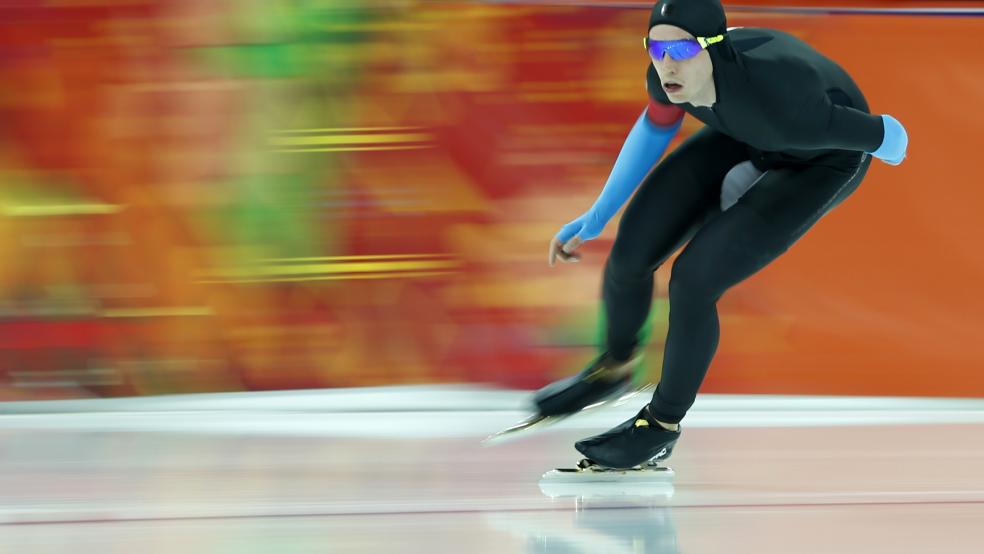The U.S. speedskating team entered the Sochi Winter Olympics with extremely high expectations — and a trumpeted technological edge courtesy of the brand new “Mach 39” skinsuits made by Baltimore-based Under Armour. It will leave with extremely disappointing results, a cloud of doubt and seemingly little else.
The question now is whether the high-profile meltdown of the speedskating team might leave Under Armour’s global growth plans on thin ice.
The surprisingly weak results of top contenders such as Shani Davis, Heather Richardson and Brittany Bowe led to suspicions about the suits that Under Armour designed in conjunction with defense giant Lockheed Martin and billed as the fastest such suit in the world. “There is a level of expertise and brain power that has never been dedicated to a uniform before," Under Armour’s senior vice president of innovation told Sports Illustrated last month.
Related: Sochi Winter Olympics - Gold Medals from 1924 to Today
Better gear won’t suddenly turn a weekend warrior into an elite athlete, but the right clothing and equipment can be a critical component of success at games like the Olympics. Speedo’s full-body LZR swimsuits, introduced in 2008, were banned as of 2010 after swimmers wearing them broke record after record, leading to complaints that they were the equivalent of “technological doping.”
"The difference between winning and losing is partly determined by clothing," Bert van der Tuuk, who designed the Dutch speedskating team’s suits, told the Associated Press. It’s a far cry from the ancient Olympic games, in which the athletes usually competed in the nude.
That sartorial edge, whether real or perceived, has also been key to the marketing of sports apparel since at least the days when Spike Lee’s Mars Blackmon character theorized on what made Michael Jordan the best player in the universe: “It’s gotta be the shoes!” So it’s little surprise then that, after a series of disappointing finishes, some bewildered members of the U.S. speedskating team floated a possible reason for their struggles: It’s gotta be the suits.
In a sport where fractions of a second separate competitors, the Under Armour skins had been developed through a secretive program that tried more than 100 different textiles in some 250 configurations. Engineers reportedly used high-speed cameras to study air flow around skaters and subjected the skins to wind-tunnel testing. The Mach 39 was not unveiled until after the U.S. team’s December Olympic trials and had not been used in competition before Sochi.
In the end, following a two-year research and testing program, U.S. athletes decided to ditch the new gear after just about a week of Olympic frustrations.
Related: Who Said Sochi Athletes Don’t Have Money Woes?
The switch back to older suits worn in World Cup competition failed to yield better results. So maybe it wasn’t the skins, after all. The company said it didn’t believe the suits were a factor, but the story line undoubtedly became a distraction for U.S. Olympians — and for Under Armour.
The company has grown quickly in recent years, posting 15 straight quarters of 20 percent year-over-year sales growth, to emerge as a force in major U.S. sports such as football and baseball. It moved into more niche sports such as speedskating as part of its plan to attract more of the world’s elite athletes to the brand and extend its reach around the world.
Founded in 1996 by CEO Kevin Plank, who had played college football at the University of Maryland, Under Armour has zoomed into the big leagues in sports apparel. The company, which started out making undershirts, had $205 million in sales in 2004 and $725 million in 2008. By last year, that had grown to $2.33 billion.
Under Armour stock has soared 1,240 percent over the last five years, far outpacing the S&P 500’s 112 percent gain over that time. The stock has more than doubled over the past year and is up 21 percent so far in 2014, even after a 2.4 percent drop on Friday.
Nike is still some ten times larger, with more than $25 billion in fiscal 2013 sales. Still, Under Armour’s presence in the U.S. is such that J.P. Morgan analyst Matthew Boss last fall described it as part of a “domestic duopoly,” with Nike, in retail window displays.
CEO Plank has told analysts that the company believes it can grow to $10 billion in sales. To get there, Under Armour has been looking to expand its product line, rolling out new cold-weather apparel; boost international sales, which still make up only a small fraction of total sales; move more women’s gear, a segment that has been growing rapidly; and keep growing its network of stores.
“Under Armour is hitting on many fronts, including with initiatives in apparel, footwear, women’s, international, a shift to full-price retail, and overall brand momentum,” Deutsche Bank analyst Dave Weiner wrote earlier this month, before the Olympics began.
Under Armour still has most of those trends going for it, and executives have said they don’t believe the hubbub over the uniforms will hurt their international expansion. Brand momentum can turn quickly, though, so Plank and his team will have to make sure the speedskating flap doesn’t become anything more than a minor speed bump on the path to continued growth.
Top Reads from The Fiscal Times:




